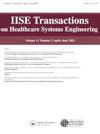利用实时定位系统减少医院急诊科的搜索时间和熵
IF 1.5
Q3 HEALTH CARE SCIENCES & SERVICES
IISE Transactions on Healthcare Systems Engineering
Pub Date : 2021-04-13
DOI:10.1080/24725579.2021.1881660
引用次数: 3
摘要
摘要尽管医院急诊拥挤的后果已经得到了广泛的研究,但拥挤的原因仍然没有得到很好的理解。在医疗需求快速变化、物理和人力资源突然变得有限的动态环境中,ED拥挤模型中的吞吐量因素很难以可控的方式进行研究。最近,随着小型非侵入性实时定位系统(RTLS)的引入,出现了对多个单元、患者和工作人员的位置和移动进行自动化、同时和低成本观察的机会。这里报道的一个RTLS部署重新开始考虑将质量和工业统计应用于医疗运营管理。提出了ED拥挤中吞吐量因子的基本结构的新度量,如效率和有效性。特别是,因果关系是根据对每个结构的理解来解释的,是根据熵、信息和顺序来建模的。实验演示了如何在不确定性较小的情况下解释劳动力减少和患者、人员和设备相遇的概率。这些新的指标有望有助于监测ED对不同拥挤程度的反应,深入了解拥挤动态,帮助评估减少拥挤的干预措施,并最终改善护理。本文章由计算机程序翻译,如有差异,请以英文原文为准。
Reducing search times and entropy in hospital emergency departments with real-time location systems
Abstract Although the consequences of hospital ED crowding have been studied extensively, the causes of crowding are still not well understood. Throughput factors in ED crowding models are difficult to study in a controlled fashion in a dynamic environment where healthcare demand changes rapidly, and physical and human resources suddenly become limited. Opportunities for automated, simultaneous, and low-cost observation of the location and movement of multiple units, patients and staff have recently arisen with the introduction of small, non-intrusive real-time location systems (RTLS). One such RTLS deployment reported here has initiated renewed consideration of quality and industrial statistics as applied to healthcare operations management. Novel metrics for essential constructs of throughput factors in ED crowding such as efficiency and effectiveness are proposed. In particular, causality is explained in terms of understanding of each construct, modeled in terms of entropy, information, and order. Experimental demonstration is given of how labor reduction and the probability of patients, personnel and equipment meeting in terms of less uncertainty can be explained. These novel metrics are expected to facilitate monitoring of how an ED reacts to different levels of crowding, provide insight into crowding dynamics, help evaluate interventions to decrease crowding, and ultimately improve care.
求助全文
通过发布文献求助,成功后即可免费获取论文全文。
去求助
来源期刊

IISE Transactions on Healthcare Systems Engineering
Social Sciences-Safety Research
CiteScore
3.10
自引率
0.00%
发文量
19
期刊介绍:
IISE Transactions on Healthcare Systems Engineering aims to foster the healthcare systems community by publishing high quality papers that have a strong methodological focus and direct applicability to healthcare systems. Published quarterly, the journal supports research that explores: · Healthcare Operations Management · Medical Decision Making · Socio-Technical Systems Analysis related to healthcare · Quality Engineering · Healthcare Informatics · Healthcare Policy We are looking forward to accepting submissions that document the development and use of industrial and systems engineering tools and techniques including: · Healthcare operations research · Healthcare statistics · Healthcare information systems · Healthcare work measurement · Human factors/ergonomics applied to healthcare systems Research that explores the integration of these tools and techniques with those from other engineering and medical disciplines are also featured. We encourage the submission of clinical notes, or practice notes, to show the impact of contributions that will be published. We also encourage authors to collect an impact statement from their clinical partners to show the impact of research in the clinical practices.
 求助内容:
求助内容: 应助结果提醒方式:
应助结果提醒方式:


